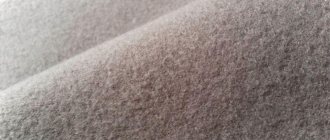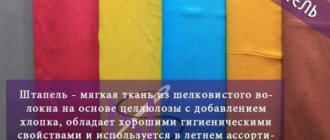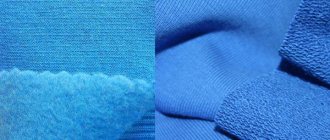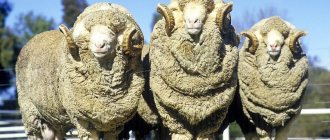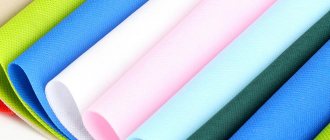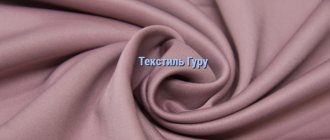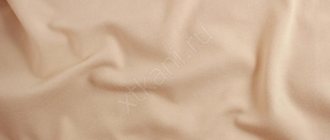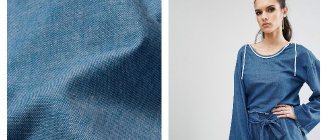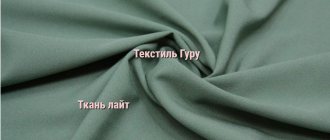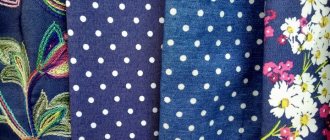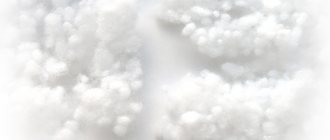What is it - lavsan
Lavsan is a synthetic material made from petroleum products, one of the types of thermoplastic. Belongs to the group of polyester fibers. The chemical name of the fiber is polyethylene terephthalate.
Polyesters are high molecular weight compounds in which the molecules are joined in complex groups. Polyethylene terephthalate is the most commonly used of the polyesters. The molecules of the substance are rigid and have a highly elongated shape.
Dacron fibers look like threads with a smooth surface, round cross-section, and slight shine. The thickness of the thread depends on its purpose.
Characteristics of lavsan:
- Hygroscopicity. Low: Dacron is waterproof. It does not deform and does not change properties in water.
- Form stability. Lavsan does not shrink when exposed to high temperatures.
- Elasticity. Elasticity is high. The fibers stretch and then return to their original shape.
- Resistant to chemicals such as acid, organic solvents and alkalis.
- UV resistance. High.
- Strength. High: the fabric is resistant to tearing and physical impact.
- Thermal insulation properties. High: the material retains heat.
- Breathability. Low.
- Combustion reaction. A white flame and black soot are formed.
- Antibacterial properties. Mylar fibers do not have suitable conditions for the development of fungi and bacteria.
- Difficulty in coloring. Lavsan does not absorb dyes well. Therefore, it can be painted only with the help of chemicals.
Dacron fiber was first invented in 1935 in Great Britain. In Russia, the development of polyethylene terephthalate was carried out by the scientist Aizenstein at the Laboratory of Macromolecular Compounds of the USSR Academy of Sciences.
By the way, the material is called lavsan only in the CIS countries; in other countries it is known under the names dacron, tergal, terylene.
To obtain lavsan, oil is used, which is repeatedly processed in different ways. As a result, ethylene glycol is obtained and combined with terephthalic acid. The resulting polymers are melted and passed through special fillers (tiny holes).
The resulting fibers are so thin that they resemble a spider's web. When hot they stick together. This produces a thread that is wound onto a bobbin or used to weave fabrics. The thickness of the thread depends on the diameter of the fillers and the number of glued fibers.
Nylon and polyethylene terephthalate belong to the same group. You can distinguish lavsan from nylon by burning. The first material will produce black soot, while the other will produce an unpleasant odor without soot.
The cost of the simplest fabric options starts from 200 rubles per meter.
Watch educational program:
Types of fabric
Mylar fibers are used to produce fabrics. They come in the following types:
- Homogeneous. This material is exclusively made from lavsan. Such fabrics are used to make linings or outer layers of outerwear, umbrellas, decorative home textiles, etc.
- Cotton. A mixture of cotton and lavsan (the latter is present in smaller quantities). Thanks to this composition, the fabric does not shrink when washed, allows air to pass through, absorbs moisture, and is durable and strong. It is used for sewing casual, home clothes, bed linen.
- Woolen. Mylar fibers are also often added to woolen threads. This reduces the cost of the finished product, makes it more durable, and protects it from deformation when wet. The fabric is used for sewing suits.
- Viscose. The fabric, which combines lavsan synthetic fiber and semi-natural viscose, is pleasant to wear, soft to the touch, and durable. Used for sewing everyday clothes.
Characteristics of lavsan
Advantages:
- very high strength and rigidity . The material is resistant to mechanical damage, as well as to the action of chemicals (resistant to acidic and slightly alkaline environments) and high (up to 170 degrees C) temperatures;
- antibacterial . Dacron does not harbor dust mites and mold; it is an unfavorable environment for microorganisms;
- water resistance The water absorption of lavsan fibers is extremely low, i.e. the fabric does not get wet, water simply rolls off;
- high resistance to deformation . The fabric does not stretch, does not stretch, does not shrink, and retains its shape well;
- durability and wear resistance . The fabric retains its properties and appearance for quite a long time;
- physiological inertia . In other words, lavsan fibers are not rejected by body tissues;
- low creasing . Lavsan fabric practically does not wrinkle and does not require ironing.
Flaws:
- moisture resistance . It is not for nothing that the lack of hygroscopicity is both an advantage and a disadvantage at the same time. On the one hand, this property is indispensable for raincoats, but on the other hand, it is unhygienic for ordinary clothing, since it does not absorb or remove excess moisture;
- difficulty of coloring . Lavsan is not susceptible to the influence of all types of dyes, for example, it is not colored by active and organic dyes;
- strong electrification . The material tends to accumulate static electricity;
- rigidity _ The material is very dense, but at the same time quite rigid.
Advantages and disadvantages of lavsan material
Lavsan has many advantages. They are presented in the list:
- Durability. The material is wear-resistant. It is not afraid of chemicals, does not wear out, does not stretch, and does not deform over time.
- Strength. Mylar fabric is durable, it is difficult to tear it with your hands, and it does not come apart at the seams.
- Water-repellent properties. Thanks to them, lavsan is suitable for sewing windbreakers and raincoats, suits for water sports, etc.
- Thermal insulation. The fabric retains heat well. It is suitable for sewing winter clothes.
- UV resistance. The material does not fade in the sun.
Matter also has quite a lot of disadvantages:
- Peelability. Pilling may form on the fabric.
- Electrification. The problem can be solved using special antistatic agents.
- Low hygroscopicity. Because of this, in the warm season, the body in products made from such material sweats a lot. Diaper rash and irritation may occur.
- Low breathability. The body does not breathe in such fabric.
Application area
Polyethylene terephthalate fibers are used both for the production of pure lavsan fabrics and for addition to other fibers (linen, cotton, wool, viscose, etc.) to produce blended fabrics.
Pure lavsan is used to make:
- tablecloths, napkins;
- curtains for bathrooms;
- raincoats, raincoats;
- umbrellas
Dacron is added to mixed materials to increase wear resistance, strength, and better shape retention. Thus, with the addition of lavsan fibers to fibers of natural origin, the finished material does not lose the properties of natural fabrics, acquiring additionally improved consumer properties.
The resulting fabrics (knitwear, pique, taffeta, satin, georgette, crepe, etc.) are widely used in light industry. Clothing made from materials with the addition of lavsan is wear-resistant, resistant to external factors, holds its shape well, does not wrinkle, and is easy to wash.
In addition to light industry, lavsan finds its application in the following areas:
- medicine (surgical threads, endoprostheses of heart valves and blood vessels) - due to the fact that the material is not rejected and does not dissolve in the body;
- chemical industry (packaging material - containers, bottles) - due to good resistance to chemical compounds and high temperatures;
- industrial equipment (conveyor belts, belts, ropes, fishing nets, drive belts) - due to increased strength and resistance to repeated mechanical impacts.
Areas of application of lavsan
Lavsan has found wide application not only in the textile industry, but also in other areas. The list shows options for its use:
- Medicine. Surgical suture material, endoprostheses.
- Packaging material. Lavsan film, solid lavsan packaging. To make the film, the mass is not passed through fillers, but is allowed to harden in a very thin layer.
- Construction. Foil-coated lavsan material is used as thermal insulation and as insulation.
- Mechanical engineering. Car tires, belts for transportation.
- Electrics. Insulation for wires.
- Sewing business. Lavsan thread, clothing.
- Filters. Filter fabric is made from lavsan fibers.
Mylar surgical suture thread
Lavsan suit
Filtered fabric
Dacron structure
Lavsan is a synthetic fabric. This fabric has universal use; it is based on polyesters. Dacron is used both as an independent material and in combination with fibers of a different nature - wool, silk, cotton.
This material practically does not wear out, is highly durable, comfortable to wear and biologically stable.
In the mid-20th century, the great minds of several countries discovered a method for producing artificial raw materials through the joint polymerization of ethylene glycol and terephthalic acid.
The compound obtained by Soviet specialists was given the name lavsan. In other countries, this substance is called Dacron, Trevira, Tergal.
In the literature, in the technical designation, lavsan is dubbed polyethylene terephthalate (PET, PET).
Polyethylene terephthalate formula: (C10H8O4)n
In some sources you can see that the compound is obtained from petroleum. Why is that? And how is this possible?
Any compound can be obtained from oil, as from a conglomerate of organic compounds. The impression that the material is derived from pure petroleum is simply incorrect. The polymer is obtained from petroleum compounds that have undergone several stages of processing. The resulting compound is granulated, melted, passed through extruders, fibers are drawn, intertwined and threads are obtained.
Material care
Lavsan is a durable, unpretentious material. However, in order for products made from it to retain an attractive appearance for a long time, they need to be properly cared for.
Washing and drying
The list contains the basic rules for washing and drying fabrics:
- Lavsan can be washed by hand or in a washing machine at temperatures up to 60 degrees.
- Any detergent is suitable, but does not contain chlorine or aggressive alkalis.
- It is not recommended to squeeze such products. They will drain quickly and dry when hung straight out.
How to iron fabric
Products can be ironed using the “synthetic” mode or at temperatures up to 150 degrees. It is recommended to place damp gauze between the items and the iron.
History of the name
The material lavsan got its name thanks to the Laboratory of Macromolecular Compounds of the Academy of Sciences, where it first appeared. The first letters of the name of the laboratory gave the name to the new substance. In other countries, polyethylene terephthalate goes by different names - Dacron in America, Tergal in France, Trevira in Germany.
In the process of improving this material, much credit goes to E.M. Aizenstein, under whose leadership the technical thread lavsan, which has special properties, was once obtained.
Making lavsan
In one of the plant’s workshops, a chemical reaction occurs, as a result of which the substances DMT and ethylene glycol are converted into a viscous, resinous mass. In the spinning shop, using special equipment, fibers are formed from it. The resin flows out in thin streams through the smallest holes. The thickness of the future thread depends on their size. The fiber spinning speed ranges from 500 to 1200 meters per minute. Thin webs are quickly glued together into a thread and wound onto a bobbin.
These fibers are not yet lavsan. What it is? For now, the resulting substance can be called an amorphous polymer, which is still unsuitable for the manufacture of products. At a certain temperature it is stretched, then heat-fixed with hot air, and only after that it is sent to weaving factories and other enterprises.
The threads, which in the future will become wool, are unwound from the bobbins and collected into bundles. Then it is pulled out, crimped, and the fiber becomes similar to natural wool. The strands are cut into pieces, the size of which depends on what natural fiber they will be mixed with in the future.
Properties
The property of lavsan is its elasticity. When stretched by 5-7%, their deformation is completely reversible, and materials made from it are indestructible.
- Polyester fibers have low hygroscopicity, therefore, in a wet state, the mechanical properties and properties of materials made from these fibers (strength, elongation, creasing, resistance to repeated deformation) do not change.
- The wear resistance of lavsan materials is also an indicator of their widespread use in the manufacture of mixed fabrics and linens. They are inferior in this only to polyamide fibers, but they are much more resistant to abrasion than all natural and artificial ones.
- Another positive property of lavsan is its resistance to most microorganisms.
All characteristics of lavsan fiber affect the mechanical and physico-chemical characteristics of the materials.
Fabrics made from polyester fibers have both positive and negative properties.
